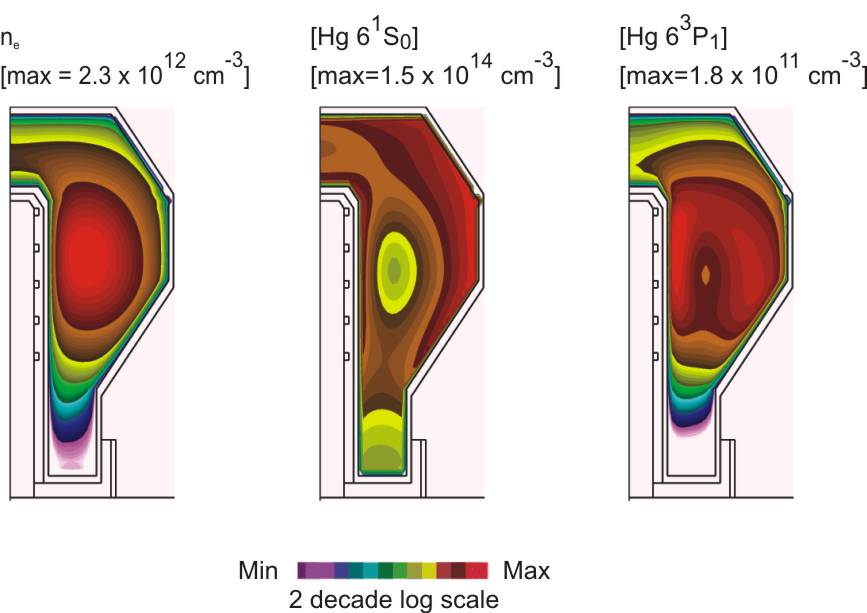

Radiation Trapping in Electrodeless Lamps*
Kapil Rajaraman
Department of Physics
and
Mark J. Kushner
Department of Electrical & Computer Engineering
University of Illinois at Urbana-Champaign
1406 W. Green St., Urbana, IL 61801
1. Introduction
Electron impact excitation of the ground state Hg 1S0 atoms in fluorescent lamps results in Hg excited states, as shown in the figure below. These atoms then either decay back to the ground state emitting a resonance photon, or are ionized by collisions with other excited atoms or by electrons. The "useful" output of the lamp is the resonance radiation at 185 nm and 254 nm that reaches the walls of the lamp. In conventional fluorescent lamps, the plasma is sustained by direct or low-frequency alternating currents, which require electrodes within the lamp to maintain the discharge. The presence of electrodes places severe restrictions on lamp design and is a major cause of failure, limiting lamp life. Recent developments in lamp technology have led to the introduction of electrodeless products, in which the power is introduced in the discharge by inductive coupling of radio frequency power from an antenna. Apart from increasing the life of the lamp due to the absence of electrodes, the possibilities exist for using new, possibly corrosive chemistries, which would otherwise damage the electrode in the conventional lamps. An example of such a lamp (Philips QL) is shown below.
The resonance radiation is absorbed and re-emitted many times in the plasma prior to striking the phosphor. This process is called radiation trapping or imprisonment. This radiation trapping lengthens the effective lifetime of emission as viewed from outside the lamp. The control of this trapping is therefore an important design consideration for low pressure lamps.

|  |
2. Computational Model
A Monte Carlo simulation has been developed to track photons from their points of emission to the points of escape from the plasma, accounting for absorptions and re-emssions. This model accounts for frequency redistribution (change in frequency between absorption and emission processes) depending on various opacity and pressure regimes. Isotope and hyperfine splits are also accounted for. Frequency perturbations due to collisional and quantum processes are also taken into account in assigning probabilities for emission and absorption. This model links to the HPEM to couple radiation transport to the plasma dynamics.
3. Results
 |
| Fig. 1: Plasma parameters (500 mTorr, 5 MHz, 5 mm Hg partial pressure, 500 mTorr Ar fill pressure). |
 |
| Fig. 2: Trapping factor dependence on cold spot temperature for the (a) 185 nm transition, and (b) 254 nm transition. Exit spectra for two isotopes at cold spot temperatures of (c) 293 K and (d) 323 K. |
 |
| Fig. 3: Exit spectra for the complete isotopic structure of Hg (a) for 500 mTorr Ar fill pressure and cold spot temperature of 300 K showing the isotopes contributing to each peak and (b) for 1.5 Torr Ar fill pressure and cold spot of 340 K. |
*This work was supported by the Electric Power Research Institute (EPRI), Osram Sylvania Inc. and the National Science Foundation (CTS 99-74962, CTS03-15353).
Last updated: August 21, 2003.